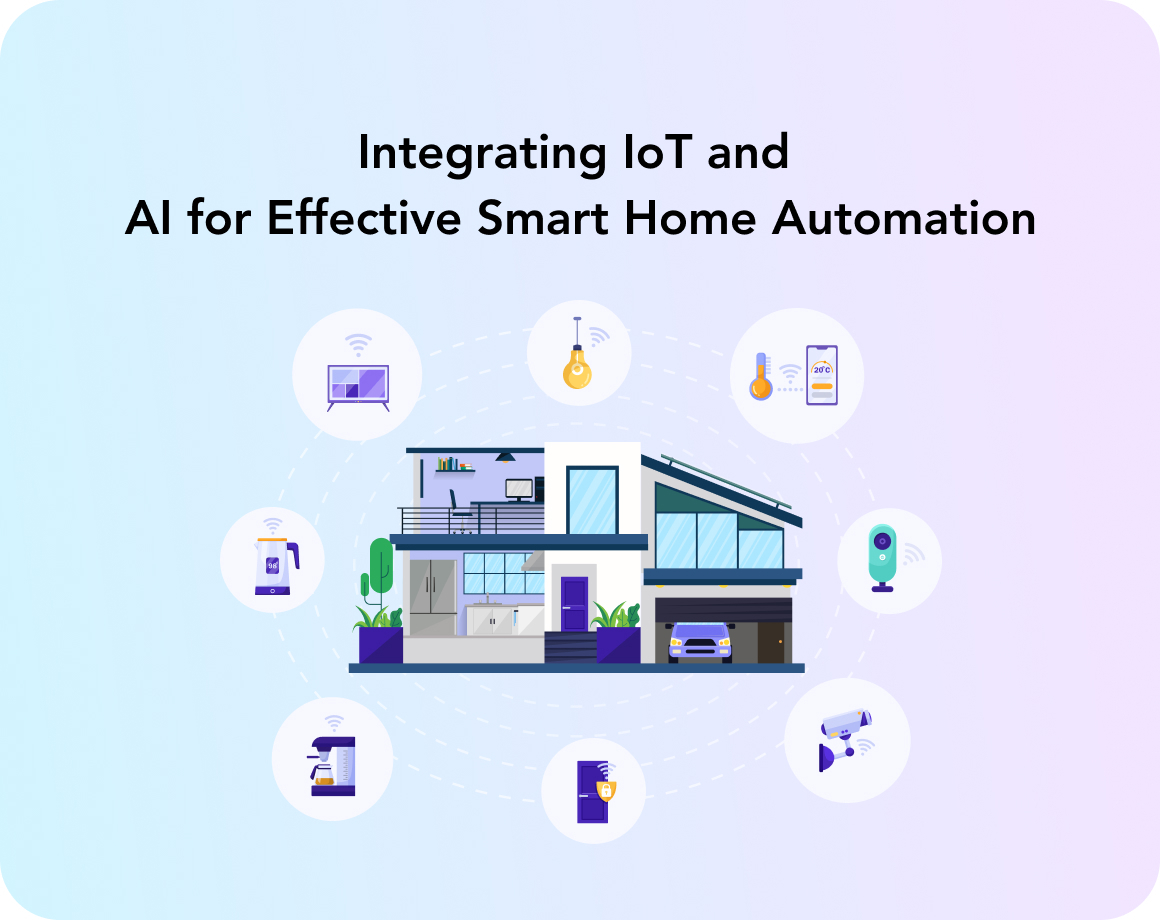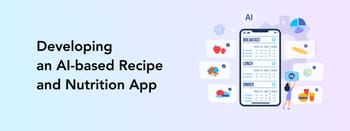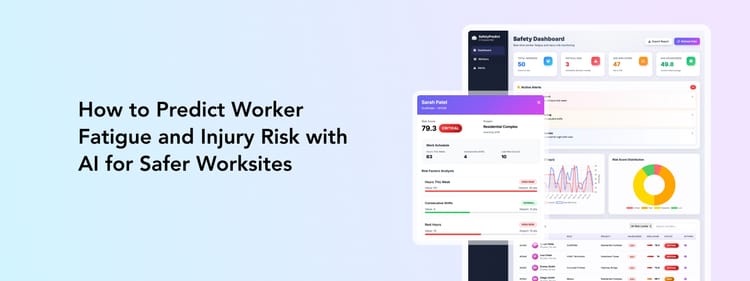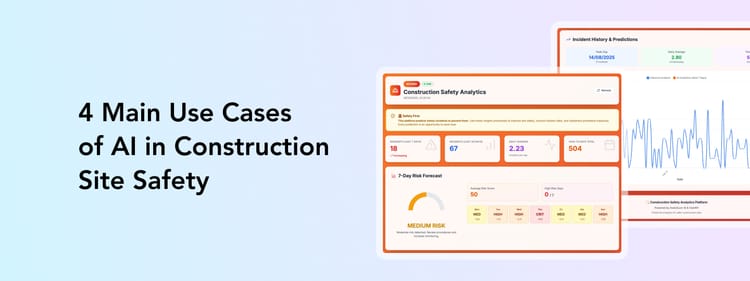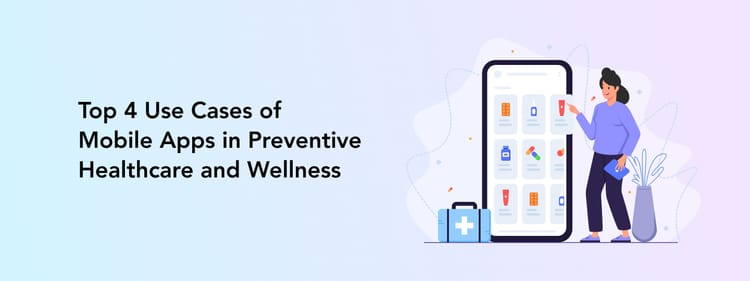Technology is here to make our lives simpler, and the Internet of Things (IoT) is a perfect example. By remotely controlling devices, IoT brings more convenience, safety, and cost savings to everyday life. But what if we told you that IoT could be even more powerful with the help of AI?
Smart homes can become even smarter (excuse us this pun) with AI offering real-time data analytics, predictive maintenance, better energy management, and more.
Let’s explore how AI increases IoT capabilities, common use cases in home automation, and how to build an AI-powered IoT solution.
How Does IoT Work?
Let's dive into the basics before exploring how AI integrates with IoT. First, it's essential to understand how IoT works and how it enhances our devices.
The Internet of Things (IoT) refers to a network of connected devices that gather data through sensors like motion or temperature, which is then transmitted to a mobile app for processing and display.
This interconnectivity makes IoT more complex than a regular app, as it involves more layers of interaction between devices and sensors. However, with a skilled IoT development team, setting up smooth data exchange between sensors and apps is manageable.
IoT applications have four main layers that help users monitor and control their devices:
Layer 1: IoT-connected devices and sensors
This layer involves the actual sensors and devices that gather data, such as temperature, humidity, motion, or geolocation. It’s the foundation of an IoT system, where all the raw data is collected and prepared for transmission.
Layer 2: IoT networks
The data from the sensors is passed through a network (e.g., Wi-Fi, Bluetooth, or cellular networks) to the main application. The network type depends on the proximity and requirements of the connected devices.
Layer 3: IoT middleware
This layer processes the collected data by converting, organizing, and storing it, often using cloud storage. Middleware ensures the data is in an accessible and unified format, making it ready for analysis or visualization in the app.
Layer 4: IoT application
This is the user-facing layer, where you can view data in an easy-to-understand format and control the connected devices. Users can monitor patterns and even interact with devices, like adjusting the thermostat or switching lights on and off.
With these four layers, IoT apps offer seamless control and monitoring, creating a foundation for advanced features like AI integration.
What Can AI Bring to IoT Solutions?
Now that we’ve explained how IoT functions, let’s dive into how AI can take IoT to the next level.
Artificial intelligence is rapidly transforming various industries, and smart homes are no exception. In fact, AI in the real estate market is projected to reach $1,803.45 billion by 2030, growing at a CAGR of 35%. AI enhances IoT by making it smarter, safer, more efficient, and personalized.
Here’s a look at the key benefits AI brings to IoT solutions:
Safer environments
While IoT devices like cameras and motion sensors help monitor properties in real-time, AI can analyze this data to detect unusual patterns or threats more accurately.
For instance, AI-powered systems can recognize suspicious behavior or unauthorized access and send proactive alerts to property owners or security teams.
Additionally, AI can register severe weather conditions, like storms, and send alerts or even take action.
Enhanced automation
IoT devices allow homeowners to control systems remotely, such as turning off lights or adjusting the thermostat from their smartphones. AI improves this by learning user behavior and automating actions accordingly.
For example, AI can predict when to adjust heating or cooling based on past preferences, weather forecasts, or occupancy patterns, providing personalized comfort and better energy efficiency without manual input. By analyzing the user's daily activity, AI can learn the pattern and suggest automatic adjustments in lighting, turn on house appliances, like robot vacuums or dishwashers, and more.
Personalized insights
While IoT sensors collect raw data, AI takes it a step further by analyzing the data to deliver meaningful insights. For example, IoT sensors in a smart home can track energy consumption across different appliances, but AI will analyze the data and alert the homeowner that, for example, their washing machine is using significantly more electricity than normal. AI can suggest optimizing usage or checking the appliance for issues, helping homeowners make smarter decisions.
Cost-effectiveness
AI algorithms can analyze data from IoT systems to identify inefficiencies and cost-saving opportunities. For example, AI can detect if certain appliances, like air conditioning units or dishwashers, are using more energy than expected. It can then recommend adjustments or suggest repairs before the issues become costly.
Use Cases of AI and IoT for Smart Home Automation
By integrating AI, IoT solutions become more powerful, providing homeowners with greater control and convenience while optimizing device performance. 25% of potential home movers in the UK already consider smart technology a "must-have," and 86% would consider a smart home when choosing their next property.
Let’s explore some of the key use cases of AI in IoT for smart home automation.
Real-time data analysis
With IoT, smart homes gather data from various devices, such as lights, thermostats, and appliances. AI can analyze the data in real-time to offer insights and automation.
For example, AI can detect patterns in electricity usage, automatically adjusting device settings to save energy or reduce costs. This could mean dimming lights when no one is in the room or lowering the thermostat when the weather is warmer based on a forecast.
Predictive analytics and maintenance
AI enhances IoT’s predictive maintenance capabilities by continuously monitoring devices like HVAC (heating, ventilation, and air conditioning) systems or washing machines.
When an issue is detected, such as a drop in efficiency due to a clogged filter, AI-powered systems can notify homeowners before the problem escalates. This prevents breakdowns, ensuring appliances run smoothly and efficiently while reducing long-term repair costs.
Better efficiency and energy management
AI-driven IoT systems enable homeowners to monitor energy consumption more effectively. For instance, AI can analyze the energy data from appliances and suggest ways to optimize their usage.
It can identify which devices consume the most energy and suggest changes, such as adjusting the use of energy-heavy appliances during off-peak hours or detecting unusual energy patterns, which could indicate malfunctions or inefficiency.
Security alerts and access control
AI boosts security in IoT smart homes by monitoring IoT-enabled devices such as smart cameras and motion detectors. For instance, AI can analyze video feeds in real-time, recognizing unusual behavior and sending instant alerts to the homeowner.
Smart locks combined with AI can learn user patterns, granting or denying access based on familiar faces and behaviors.
Additionally, AI helps detect potential risks like fires or water leaks through IoT sensors and responds immediately by notifying homeowners via a mobile app.
Personalization
AI integrated with IoT makes homes more personalized. Based on a user’s routine, AI can adjust the environment to their preferences — automatically setting lighting, temperature, and even entertainment systems. The more data AI gathers, the better it becomes at predicting and adapting to the homeowner’s needs.
Accessibility
AI-powered IoT systems make homes more accessible, allowing users to manage their devices remotely from anywhere. Whether it’s adjusting security cameras, controlling heating, or receiving notifications about an appliance malfunction, AI ensures seamless connectivity and access. It can also detect behavioral patterns and alert users if something seems out of the ordinary, offering added convenience and peace of mind.
How Can An AI Smart Home Look Like
We’ve covered many benefits and use cases of AI in smart homes, but how does this combination of AI and IoT translate into everyday devices? Let’s take a look at how AI and IoT can come together in practical, physical smart home devices:
- Smart speakers: AI-powered smart speakers not only play music and respond to voice commands but also learn from user preferences to provide personalized recommendations and control other connected home devices, from thermostats to security systems, enabling voice-controlled automation throughout the home.
- Smart TV: Today’s smart TVs use AI for improved picture quality and voice command control. Streaming services also leverage machine learning to recommend content. With the reintroduction of cameras, AI-driven features like home fitness, gaming, and video calling are becoming more common.
- Smart lighting: AI can optimize energy use by adjusting lighting based on patterns of activity, brightness preferences, and even the time of day, creating a more energy-efficient and responsive environment. Users can activate complex scenarios with simple phrases like "I am at home" or "I left home" and control lights, electric drapes, gates, and door locks with just their voices.
- Cameras: AI-enhanced cameras can detect unusual behavior or intrusions, alerting users in real-time while also analyzing the footage to differentiate between familiar faces and strangers.
- Smart refrigerator: There are already refrigerators that track the items inside and suggest recipes based on what's available. At Perpetio, we’ve developed a similar app where users can receive recipe recommendations based on certain products they have on hand. An IoT enthusiast describes how the Samsung smart refrigerator holds a surprising amount of personal data: "It stored details about Bluetooth devices near the fridge, user account information like email addresses and home Wi-Fi networks, and even photos of the Diet Coke and Snapple on the shelves, thanks to the small embedded camera."
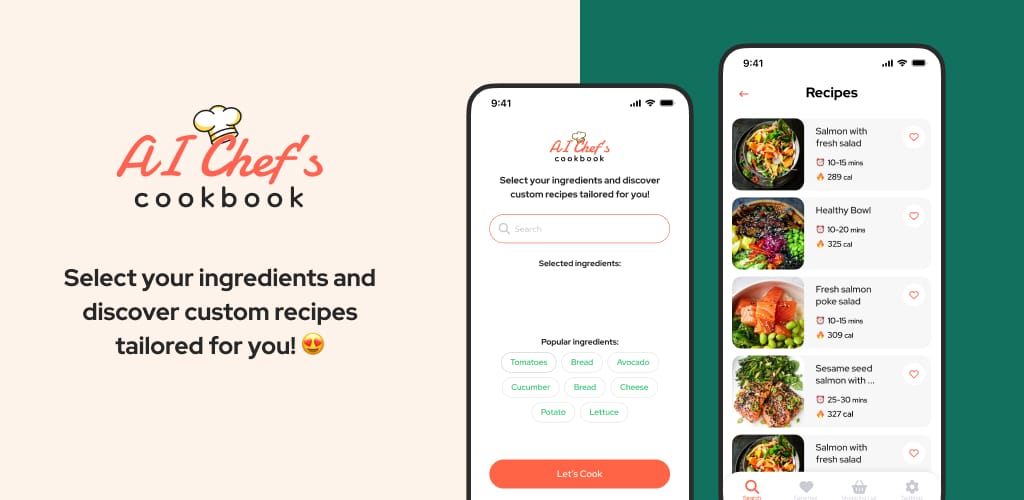
- Robot vacuum: AI-powered robot vacuums can map out your home, learn about areas that need more attention, and even suggest cleaning schedules based on activity levels in different rooms.
- Smart thermostat: AI integrated into smart thermostats can analyze usage patterns and weather forecasts to adjust heating and cooling more efficiently, improving comfort and reducing energy consumption.
Surely, this is not the full list. The device choice is wide, and many more house appliances can be turned "smart" with IoT and AI technologies.
How to Integrate AI into IoT Devices
As we have mentioned above, creating an IoT product takes more than a regular app or platform, as it involves interconnectivity with a number of devices. Add AI integration to it, and you definitely need a professional and experienced development team to undertake the task.
At Perpetio, we developed a bunch of IoT solutions, like a smart HVAC system app or energy consumption app, so we have established a straightforward IoT development process, including integrating AI capabilities.
Let us guide you through the essential steps your development team should follow to effectively combine AI with IoT technology.
Step 1: Define clear functional and non-functional requirements
The first crucial step is to define clear functional and non-functional requirements for the IoT application. This process ensures that your development team has a comprehensive understanding of what the final product should achieve.
Functional requirements:
- Device compatibility: Determine which IoT devices will connect to the app and ensure they are compatible with communication protocols such as Wi-Fi, Bluetooth, Zigbee, or others.
- Data collection: Identify the types of data collected by the devices, the frequency of data collection, and the expected volume of data from each device.
- User control and interaction: Specify which features users can control or interact with via the app, such as remote monitoring, setting adjustments, or receiving notifications and alerts.
- Real-time monitoring: Assess whether real-time monitoring is necessary and how quickly the app should provide updates or alerts.
- Data visualization and analytics: Determine if data visualization tools are needed to display data in graphs, charts, or dashboards, and consider the analytics or insights required from the data.
Non-functional requirements:
- Performance: Define the expected response times when interacting with devices or displaying data and the number of concurrent users the app should support.
- Scalability: Plan for future expansion, considering the addition of more IoT devices or users, and how the app will scale accordingly.
- Security: Establish necessary security measures to protect data and communications, including user authentication, data encryption, and secure access controls.
- Reliability and availability: Evaluate the importance of app and device availability to your operations.
- Usability and accessibility: Ensure the app’s interface is intuitive for users with varying technical expertise and addresses accessibility needs.
- Compliance and regulations: Identify any industry regulations or standards (e.g., GDPR, HIPAA) the app must comply with and the data privacy requirements.
- Integration and interoperability: Determine if the app needs to integrate with other services, platforms, or APIs and how it will ensure interoperability with different IoT devices.
- Maintainability and support: Plan for ongoing maintenance, updates, and support, including documentation and training resources.
Don't worry if you cannot fully understand each parameter and give precise requirements; your development team will assist with coming up with a requirement list based on the product's design, scale, and specifics.
Step 2: Choose appropriate IoT sensors and firmware
With requirements defined, your development team will select the appropriate sensors and firmware. Choosing the right sensors is crucial for accurate data collection. Depending on the application, you might need temperature sensors, humidity sensors, motion sensors, or others.
The developers will ensure that the sensors are compatible with your IoT platform and support the necessary communication protocols. They will also verify if the IoT platform offers SDKs or APIs for integrating these sensors.
Firmware, embedded software controlling hardware operations, should be selected based on compatibility with sensors, support for communication protocols, and required reliability and security features. For AI integration, consider firmware that supports edge computing if real-time processing is needed.
Step 3: Select the network and protocols for connectivity
Next, focus on selecting the network and protocols for data transmission from IoT devices to the cloud. Your development team should evaluate network options like Wi-Fi, Bluetooth, and cellular networks, considering factors such as power consumption, data transmission speed, range, and security. The network choice must align with your existing infrastructure and meet the needs of the IoT application.
For integrating AI, ensure the network supports efficient data transfer and processing. The network should handle latency requirements for AI processing, enabling smooth communication and rapid data handling.
Step 4: Establish a data processing flow and choose cloud storage
Once the network and protocols are set, establish a data processing flow and select suitable cloud storage solutions. Your team should define key data collection points from IoT devices, implement data acquisition mechanisms like pipelines or APIs, and preprocess raw data for analysis.
Determine if real-time processing is needed for immediate analysis or if batch processing is required for historical data when you don't need real-time insights.
Choose a cloud provider offering scalable and reliable storage options, such as object storage, relational databases, or data lakes. Ensure the chosen storage solutions comply with industry regulations and data privacy standards, implementing encryption, access controls, and auditing mechanisms to secure data.
Step 5: Build a mobile app
The final step is to develop a mobile app to interface with your IoT solution. This app should translate requirements and design concepts into a functional application. Decide whether to develop for iOS, Android, or both platforms. Cross-platform frameworks like React Native or Flutter can be used to streamline development across multiple platforms.
The development team will incorporate AI features into the app to enhance user experience, such as personalized recommendations or predictive analytics.
Incorporating AI into your IoT smart home app involves selecting the right technologies and APIs to achieve the desired functionalities.
The last step before the release is testing to make sure the final product performs correctly and provides adequate user experience.
Consider Perpetio Your Trusted Partner
Take a look at our recent smart meter application to see how we turn raw energy consumption data into actionable insights. Our aim was to enhance user experience through personalized features and automation, using AI to make energy management more intuitive.
We designed a graph system that shows energy consumption trends over various time intervals—daily, weekly, monthly, and yearly. The app uses AI to analyze data and provide personalized recommendations, helping users optimize their energy usage based on their habits.
In addition, the app integrates automation features that adjust energy settings according to user preferences and historical data. Detailed insights into individual devices’ energy consumption are presented in kilowatt-hours (kW/h) and percentage formats, making it easier for users to manage their energy use effectively.
At Perpetio, we focus on blending technology with practical solutions to meet your smart home needs. If you’re interested in developing a smart home product that combines AI, data analysis, and automation, reach out to us. We’re here to help turn your ideas into reality.
